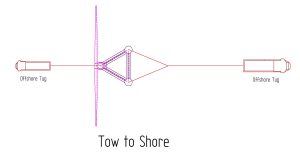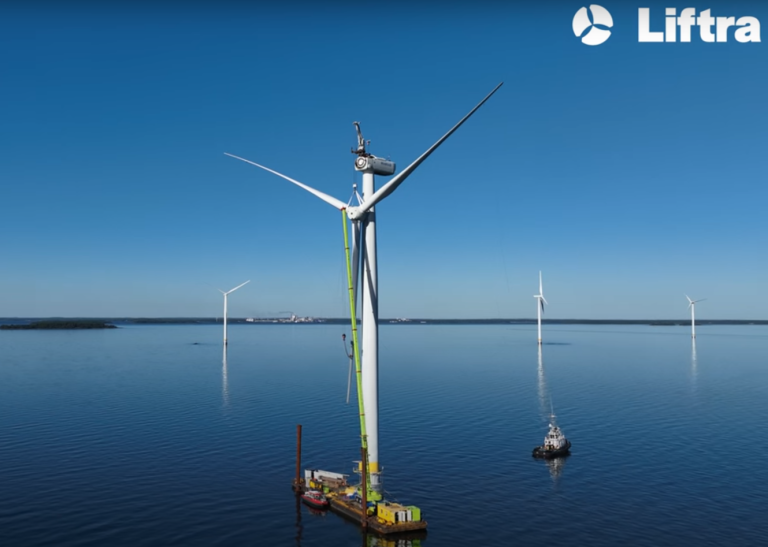Floating offshore wind faces a dilemma not met in fixed bottom projects. The question is how to perform turbine major component exchange (MCE); To tow, or not to tow?
MCE operations at floating sites will be substantially different from today’s fixed-bottom practices. Fixed-bottom MCE is typically executed using a jack-up vessel, but floating windfarms are deployed in water depths beyond the capability of jack-up vessels. A lift from a jack-up vessel to fixed-bottom turbine is a simple fixed to fixed lifting operation. The maintenance of floating turbines in deep water represents a more complex floating to floating lifting operation. Currently there are three options for MCE of floating wind turbines: Tow to Shore, Turbine- or Floater-Mounted Cranes and Vessel-Mounted Cranes.
Solving the range of challenges influencing each method is critical if floating wind is to succeed. Tow to Shore MCE is the most mature option, having been carried out at the operational Kincardine floating windfarm in Scotland. Turbine or floater mounted cranes require significant technological maturation before commercial roll out. While there are some floating vessels with cranes of sufficient hook height, they are in very short supply and are expensive. It is highly unlikely that these units will be a commercially competitive option for MCE. Novel floating O&M-specific crane vessel concepts do exist. However, vessel operators must have a pipeline of projects to create a clear business case, before committing to build them.
Tow to Shore MCE involves releasing the floating structure from its moorings & inter-array cables, then towing to either a port to perform MCE with a shoreside crane or a shallow & sheltered location suitable for a jack-up vessel. Similar operations are performed in reverse to return the unit to service. While Tow to Shore avoids the use of costly large marine assets, it is not without significant challenges. Some of these challenges include:
- CAPEX-OPEX trade-offs between a mooring quick connect solution (such as Balltec MoorLOK) with in-line buoyancy for near surface wet storage versus a more traditional connector (such as fairlead & chain stopper) and seabed wet storage.
- Similar trade-offs between an electrical out-of-service arrangement that provides electrical continuity (such as the Principle Power I-tube spar) versus traditional terminations.
- Variations in the towing marine spread for differing floating substructure typology.
- Towing equipment requirements (navigation lights, bilge pumps, spares, etc).
- Infrastructural constraints at shore (cranage, draft, etc)Administrative requirements with associated lead times (marine & aviation licenses, insurances, etc).
Turbine- or Floater-Mounted Cranes involve using a support vessel to deliver a temporary crane onto either the floating substructure or the WTG itself. The temporary crane then performs the MCE and is demobilised back to shore. The known concepts are largely immature. Present day “marine” deployments are limited, such as Liftra’s LT1200 at Wind Park Vänern, Sweden in August 2022. There are several challenges to the use of Turbine- or Floater-Mounted Cranes:
- The breadth of concepts available.
- Crane concept compatibility with different floating substructure typologies.
- Support vessel requirements.
- Potential WTG modifications.
- Complexity of mobilisation & demobilisation.
- Potential to not be capable of executing MCE of all component types.
Vessel-Mounted Cranes involve the use of a floating crane vessel with sufficient hook height and lifting capacity to perform the MCE. While this most closely resembles fixed-bottom practices, challenges include:
- Sophisticated motion-compensation systems are needed to execute the floating-floating lift.
- Vessels of sufficient hook height are currently of extremely limited supply.

MCE for floating wind turbines is a topic, like floating substructure typology, where industry has not yet reached consensus on the preferred solution. The preferred solution might be different depending on several site characteristics. For floating wind operations & maintenance to reach cost competitiveness, each of the potential MCE methods, Tow to Shore, Turbine- or Floater-Mounted Cranes and Vessel-Mounted Cranes, must find solutions to an array of challenges.
Featured Image: Liftra on YouTube: https://www.youtube.com/watch?v=5sSpWPMIa4g

